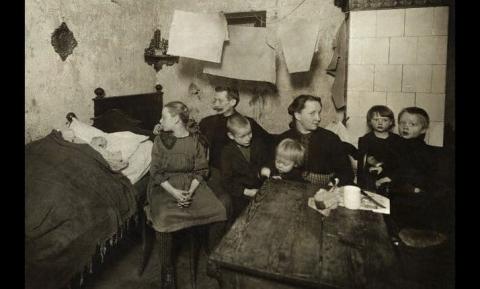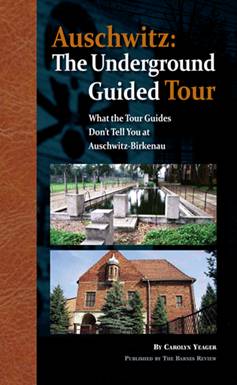A Folk Without Space
From the Handbook for Schooling the Hitler Youth
Chapter Eleven: Territory and Population (Handbook online is here)
Large German family after 1919 with insufficient living space.
The following has been edited for greater brevity -cy
Before we consider the everlasting earthly foundations of our economic life we must investigate the relation of territory and population, the relation of population density and population distribution. For they are of decisive significance for the social and economic life of the German people. The soil cannot feed an indefinite number of persons. It cannot provide an indefinite number of possibilities for work. There is a limit to such possibilities, as soon as this limit is reached a people must win new territory if it does not wish to lower its whole standard of living.
The peoples of the earth are very unequally situated. Some rule over such large areas that they are unable, by themselves, to get the full benefit out of them. Others suffer from a lack of territory and are forced to leave many talents unused because their limited territory deprives them of sufficient opportunities to live.
Territory and population do not remain forever in the same relationship. Peoples are living beings; they wax and wane. Political areas change also, they are extended and contracted. The German Reich has undergone continual changes during the course of history. Since the beginning of the 15th century it has steadily grown smaller in size. Attacks from without and dissension within have given it its present very small dimensions. Even in Bismarck's time, the Reich was about 70,000 square kilometers greater in size than in 1919. The Reich of the middle ages was about six time as large as it is today.
The development of the population was exactly the reverse. At the time of Charlemagne, the Reich had 3 million inhabitants; at the time of Barbarossa it had 8 million; at the time of the Reformation about 16 million; about the year 1800 over 24 million; by the turn of the last century almost 56 million; and finally in the year 1911 over 67 million inhabitants.
A progressive diminution in the political area [established borders -cy] of the Reich was accompanied by the pressure of an ever increasing population.
The political area was further reduced in size by the infamous dictate of Versailles, at the same time that the return of Germans from all over the world necessitated an increasing need for territory.
12,000 Germans returned from Lithuania and Estonia,
15,000 Germans from Memel,
40,000 Germans from Russia,
900,000 Germans from Posen-West Prussia,
100,000 Germans from Upper Silesia,
125,000 Germans from Alsace-Lorraine,
54,000 Germans from France,
2,000 Germans from Eupen-Malmedy,
3,000 Germans from Belgium,
2,000 Germans from North Schleswig,
13,000 Germans from German colonies.
And many thousands from other parts of the world were forced to return to the Reich. [See chart 25 in online book here]
How Germany compares to other European nations
Since the end of the World War, therefore, the need of our people for territory has increased to an extent which is unendurable. The expression “folk without space” which was coined during the years following the War is more applicable to Germans than to any other people in the world. That is shown by a comparison of the population density of the larger states of the earth.
The population density is the number of inhabitants living on one square kilometer of definite territory. It's easily seen that this measure gives an incomplete picture of the true relation between territory and population. For no consideration is given to the productivity of the soil, the climate, and the minerals. Moreover, men vary with respect to their cultural attainments, manner of living, and talents. In this, the German situation was presented in a much more favorable light than it really is. For the soil of the German Reich is less favorably endowed by nature than is the case with most other lands, while the social and cultural needs of Germans are higher than those of many other peoples. In spite of all this, the figures for population density remain the only possible bases of comparison.
The German Reich has a territory of 470,715 sq. kilometers and a population of 67.7 millions (end of 1936). This gives an average population density of 144 persons per sq. kilometer. The territory of the Reich amounts to 3.0 per cent of the earth's surface, but is 3.3 per cent of the total earth population, making it 10% greater than that of the whole earth. The population density of Europe is 50 persons per sq. kilometer, three times less than the density of Germany.
Among the European states only Belgium, Holland and Great Britain have a greater population density. After Germany comes Italy and Czechoslovakia. All other European states have less than 100 inhabitants per sq. kilometer. However, the three states which are more thickly populated than Germany possess enormous colonial empires. Italy, France, Spain and Portugal also possess large colonial territories which are many times larger in size than the motherland. For example, the colonial possessions of England are 150 times the size of the motherland, Belgium 80 times, Holland 60 times, Portugal 23 times, and France 22 times the size of the motherland.
The need for colonies
The wealth of colonies in terms of raw materials and foodstuffs reduces the significance of population density in these lands. Such an adjustment is not possible for the German Reich since, among all the great European powers, it is the only one to be deprived of colonies. Its colonies were developed with great success and heavy oulays before the World War, and were stolen by the dictate of Versailles, abetted by one of the greatest lies in the history of the world. [Until the even greater lie of the “Holocaust” hoax was dreamed up, that is. -cy]
A true comparison between the European states can only emerge when both homelands and colonies are considered. No matter how the comparison is made, a striking difference always results between the great lack of room for our people and enormous territory at the disposal of the remaining world powers. Our claim for a corresponding share of earthly possessions, of raw materials, and foodstuffs is based on the past and present achievements of our people in all spheres of life. Only blind hate or lack of political wisdom can deny this inalienable claim.
For this reason the solution of the colonial question is and remains the basic condition for an enduring world peace and for a happy working together of all peoples.
Over-industrialization
The overpopulation of the Reich, combined with the impossibility to obtain more land peacefully resulted in over-industrialization, with the result that the economic structure of the German Reich became very one-sided and lacked organic unity.
As a result of industrialization, flight from the land was strongly encouraged. The younger sons of farmers no longer attempted to win new land by clearing, cultivating, or improving it, but went into cities which offered them more agreeable living conditions. As a result, the agricultural estate became smaller and smaller in relation to the number of consumers in the cities. The population of the large cities increased about six-fold after 1870, while the farming population decreased accordingly. The number of metropolitan cities grew from 8 in 1870 to 56 in 1930. The rural population declined from 59 per cent to 33 percent in 60 years, while the urban population rose from 41 to 67 per cent. [See chart 26 in online book here]
The cities received their principal additions from the rural areas of the German east. From East Prussia alone about three-quarters of a million migrated to the industrial west. The consequence is that, in the eastern regions of the Reich, less than 70 persons on average live on a square kilometer of land, while in Saxony 311 and in Westphalia 222 persons crowd together on the same space. The flight from the land thus became a national danger. For it is right here in the east that the flood of Slavic peoples with a very high birth rate surges against our frontiers. The last century has shown us, with the examples of West Prussia and Posen, what kind of a fate threatens an underpopulated area.
Economic disadvantages: The German Reich became more dependent upon foreign countries for raw materials. Soon the feeding of our people was only possible with the help of large imports of foodstuffs. The whole economic structure became so susceptible to crises that the slightest fluctuations were accompanied by grave dangers.
The National Socialist state has clearly recognized the dangers resulting from both overpopulation and an unbalanced distribution of the population, and has straightaway undertaken remedial measures. The National Agency for Territorial Research investigates and prepares measures for bringing about a better distribution of settlements. The most important plans thus far are those dealing with the depopulation of the metropolitan cities, the homesteading program in the east, industrial planning, and in general the fostering of an economic structure capable of withstanding crises. The following chapter tells how the security of our food supplies and the provision of sufficient raw materials are on the way to being realized.~
Category
National Socialism, Schooling Hitler Youth, World War 1- 616 reads











Comments
The german nationalist
The german nationalist worldview is always spot on!
Hitler even compared the necessity of territorial expansion to the East with the american colonists conquering living space in the american West. In Europe, the uncultured Russians had to give way to the german far superior culture in the same way as the american indians in North America.
The Russians under german supervision would live far better than under self-rule as every single russian ruler is a despot to his own people.
In the few german colonies in Africa generally the natives were well treated.